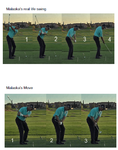- Joined
- Dec 26, 2017
- Messages
- 24,286
- Reaction score
- 25,829
- Handicap
- 17.2
No. I'm saying the start of the swing. Not the downswing.
Thats why I was asking Tadashi to clarify whether he meant the downswing and not the start of the swing.
I actually start with a push of my left foot into left hip into right shoulder, everything goes back from the ground up and ends with the weight of the clubhead pushing my left thumb down gently, then I push everything back through from my right foot.















